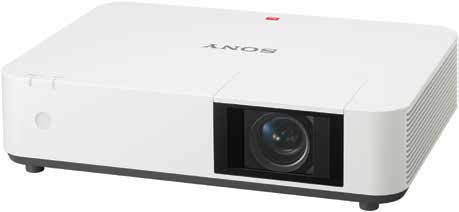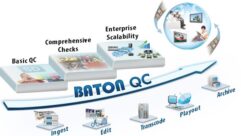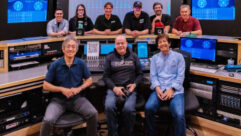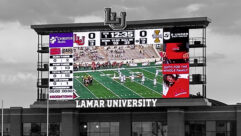

Sony has been in the laser projection business since 2013. They have two broad lines of projectors that are aimed at the installation market. One is what Sony refers to as the “Advanced” installation line. These are the full-featured projectors that include much higher light output, interchangeable lenses, and support for a wide array of geometry adjustments.
The folks at Sony have focused their latest development efforts on creating laser-based projectors that are smaller, lighter, and affordable for a wide range of venues. I will say here that laser projectors still command a slight premium in pricing, but when you look at the cost of ownership, Sony laser projectors in their basic line need to be considered. There are two new 3-chip LCD projectors that are worth a serious look: the VPL-PHZ10 and the VPL-PWZ10.
Here we will take a closer look at the VPL-PWZ10. And, while I like the higher native resolution of the VPL-PHZ10 1920 x 1200 (WUXGA), often budget constraints limit our options. When we have to stretch the budget, we look for the best value for the budget. Sony has specifically aimed these projectors at higher education classrooms, but they are certainly suitable for many small to medium venues. Even though the VPL-PWZ10 is not a full 1920 x 1200 (WUXGA) resolution, I was surprised by the visual performance of the projector, including Sony’s latest deployment of the impressive Reality Creation algorithm. This projector also provides features important to installation while keeping an eye on the budget.
So, if you are among those who have wanted the benefits of laser projection at an affordable price, keep reading.
The VPL-PWZ10 is a 3-chip LCD projector with a native resolution of 1280 x 800 pixels (WXGA). The engine produces a respectable 5000 Lumens at full brightness. It has three other brightness settings that allow the light output to be adjusted. Two are energy saving by reducing the light output from standard to “middle” or “low;” the third is an automatic setting that will make adjustments based on the image content.
As for connectivity, the VPL-PWZ10 provides a nice mix of options that allow this unit to be installed in almost any retrofit application. There are two analog connections, VGA, and composite video. As for digital connections, Sony has included two HDMI connections and an HDBaseT port.

The unit is also quiet, rated at 36dB at standard output. I am always a bit wary of noise ratings, but I was able to confirm the measurement. In most installations, this small amount of noise is not noticeable, and considering that most classrooms are not the quietest of places, this projector will not be a distraction.
There are no lens options, but the design goal was to keep the projector cost down. Sony did develop the lens for this projector with a wide enough throw-range (1.28 to 1.88:1) to accommodate most installation applications.
Often when we need to replace a projector in a classroom or conference room, the ideal solution is to find a projector that can be located on the existing mount. With the lens Sony incorporated into the VPL-PHZ10, it can be an easy replacement. When it comes to lens shift capabilities, I found that both vertical and horizontal lens shift adjustments work well. While not motorized, the adjustment range is from +20% to ±55% vertically, and 10% horizontally; wide enough to accommodate most applications. By making this operation a manual one, Sony has kept an eye on the cost of the projector and still provided a very serviceable feature set.
Sony has done a very nice job of providing the VPL-PWZ10 with important capabilities and I would like to highlight the significant ones.
With the VPL-PWZ10 (and the VPL-PHZ10), Sony has produced projectors that require next to no maintenance for their entire useable life. Of course, the typical life span of a laser engine is in excess of 20,000 hours, so the first advantage is no lamp replacement.
Looking beyond the lamp replacement there is a cost for maintaining a projector that has to include filter cleaning, or replacement, color adjustment and the technician time to perform the services. Sony has addressed these costs by providing the projector with features that do the maintenance tasks for us.
As you would expect, the projector engine is protected by air filtration and even if there is no lamp to replace, we are used to regularly inspecting, cleaning, or replacing the filter at regular intervals. The VPL-PWZ10 includes a filter cleaning system, which Sony says will last the life of the projector. So, in theory, there is no technician time required for the usable life of the projector.
I was curious about how this worked, so I ran a test on the self-cleaning filter. Within the menu, I chose the filter cleaning cycle option. I was instructed to turn the projector off. That seemed odd, but I did as I was instructed. A few seconds later there were two audible thumps from a clever little hammer that taps on the filter to shake dust loose.
Sony has also developed a system that monitors the color performance of the projector and will regularly adjust it to keep the VPLPWZ10 looking good. Then Sony took this concept one step further. They created a constant brightness mode. For the sacrifice of a few lumens of light, (5000 Lumens down to 4500 Lumens) the projector will maintain the same brightness over 14,000 hours of use with no noticeable dimming. Here again, Sony has done a great job of providing a projector that will perform well over an extended period of time.
Sony has also provided a timer-based system that will keep an eye on the use of the projector. With the feature activated, I left an image on the screen and a few minutes later there was a noticeable but slight reduction in overall image brightness. I waited a little longer and the image brightness dimmed significantly. As soon as I made any change in the image, the projector returned to its full brightness.
Keeping the mechanical installation of a projector looking professional can be extra work. With the VPL-PWZ10, it is the little things that add up to a big value. While the VPL-PWZ10 is a projector for the budget conscious, it is not without some very valuable installation features as well. While looking over the projector, I found a small tie bar near the power connector. It allowed me to tie down the projector cables to be neatly bundled and anchored to the projector frame.
When we have to replace a projector, we have to look to see if the lens position on the new projector matches the location on the old projector. Some are centered and some are offset to one side. This may not seem like a major problem, but the lens position on the face of the projector impacts the exact mounting location. The VPL-PW10 has a lens that is offset to one side and when replacing a projector that had a centered lens, this offset difference can cause a significant increase in replacement labor. When I turned the projector over, I discovered that Sony solved the problem by providing two sets of mounting inserts. This way, the installer need only use the right set of inserts to match the previous projector. After that, any remaining minor position error can easily be addressed with the horizontal lens shift.
The projector also comes with corner geometry correction adjustments and the keystone adjustments—features typically found on more expensive projectors.
Sony continues to create innovative features to improve the projector performance, including the latest application of Reality Creation to the VPL-PWZ10 and the VPL-PHZ10. This was exciting to see in action. This feature and its companion Contrast Enhancer are designed to improve fine detail and contrast—with an effort to approximating 4K.
To my eye, when I activated the Reality Creation feature, the difference in the WXGA projector’s image performance was significant. From my observation, it works well enough to seriously consider the application of WXGA projectors where budget dictates. This you need to see.
I have been involved in the design and implementation of displays for a long time and clients seem to demand features that drive prices up and simultaneously expect lower costs. I have always focused attention on cost of ownership and not just the initial price. Along comes Sony with the VPL-PWZ10 and they build a projector for installation with just about everything you might need. With a long list of features—starting with making the installation easier, providing a quality user experience, and then reducing the maintenance costs to near zero.
This projector is the thoughtful application of hardware and software features that make the unit a worthy competitor. Sony has positioned these projectors to compete with lamp-based projectors. Finally, typical equipment replacement cycles range from 5 to 7 years and with the Sony 5-year warranty, the VPL-PHZ10 is a projector that can just run, worry-free, for a long time; possibly for the entire depreciation cycle.










